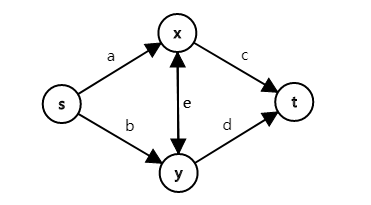Harmonious Army
时间限制: 1 Sec 内存限制: 128 MB题目描述
Now, Bob is playing an interesting game in which he is a general of a harmonious army. There are n soldiers in this army. Each soldier should be in one of the two occupations, Mage or Warrior. There are m pairs of soldiers having combination ability. There are three kinds of combination ability. If the two soldiers in a pair are both Warriors, the army power would be increased by a. If the two soldiers in a pair are both Mages, the army power would be increased by c. Otherwise the army power would be increased by b, and b=a/4+c/3, guaranteed that 4|a and 3|c. Your task is to output the maximum power Bob can increase by arranging the soldiers' occupations.
Note that the symbol a|b means that a divides b, e.g. , 3|12 and 8|24.
Note that the symbol a|b means that a divides b, e.g. , 3|12 and 8|24.
输入
There are multiple test cases.
Each case starts with a line containing two positive integers n(n≤500) and m(m≤104).
In the following m lines, each line contains five positive integers u,v,a,b,c (1≤u,v≤n,u≠v,1≤a,c≤4×106,b=a/4+c/3), denoting soldiers u and v have combination ability, guaranteed that the pair (u,v) would not appear more than once.
It is guaranteed that the sum of n in all test cases is no larger than 5×103, and the sum of m in all test cases is no larger than 5×104.
Each case starts with a line containing two positive integers n(n≤500) and m(m≤104).
In the following m lines, each line contains five positive integers u,v,a,b,c (1≤u,v≤n,u≠v,1≤a,c≤4×106,b=a/4+c/3), denoting soldiers u and v have combination ability, guaranteed that the pair (u,v) would not appear more than once.
It is guaranteed that the sum of n in all test cases is no larger than 5×103, and the sum of m in all test cases is no larger than 5×104.
输出
For each test case, output one line containing the maximum power Bob can increase by arranging the soldiers' occupations.
样例输入
3 2
1 2 8 3 3
2 3 4 3 6
样例输出
12
题意:给n个士兵安排两种职业,有m个关系,关系的贡献与该关系两边的士兵的职业有关,求最大贡献和。
最小割建图好题,Mark一下。思路参考题解:
对每个士兵建立一个点x ,点x 向源点s 连一条边,向汇点t 连一条边,分别表示选择两种职业,然后就可以先加上所有的贡献,通过两点关系用最小割建模,如下图所示。
设一条边的三种贡献为A;B;C,可以得到以下方程:
a+b=A+B(x,y都选Mage)
c+d=C+B(x,y都选Warrior)
a+d+e=A+C(x选Mage,y选Warrior)
b+c+e=A+C(x选Warrior,y选Mage)
可得一组解a=b=(A+B)/2,c=d=(C+B)/2,e=-B+(A+C)/2,然后将所有有关系的两点的图合并,用所有贡献减掉这个图的最小割即可。

#include<bits/stdc++.h> #define N 505 using namespace std; typedef struct { int to,next; long long flow; }ss; ss edg[N*N]; int now_edge=0,s,t; int head[N]; void addedge(int u,int v,long long flow) { edg[now_edge]=(ss){v,head[u],flow}; head[u]=now_edge++; edg[now_edge]=(ss){u,head[v],0}; head[v]=now_edge++; } int dis[N]; bool bfs() { memset(dis,0,sizeof(dis)); queue<int>q; q.push(s); dis[s]=1; while(!q.empty()) { int now=q.front(); q.pop(); for(int i=head[now];i!=-1;i=edg[i].next) { ss &e=edg[i]; if(e.flow>0&&dis[e.to]==0) { dis[e.to]=dis[now]+1; q.push(e.to); } } } if(dis[t]==0)return 0; return 1; } int current[N]; long long dfs(int x,long long maxflow) { if(x==t)return maxflow; // printf("%d %lld\n",x,maxflow); for(int i=current[x];i!=-1;i=edg[i].next) { current[x]=i; ss &e=edg[i]; if(e.flow>0&&dis[e.to]==dis[x]+1) { long long flow=dfs(e.to,min(maxflow,e.flow)); if(flow!=0) { e.flow-=flow; edg[i^1].flow+=flow; return flow; } } } return 0; } long long dinic() { long long ans=0,flow; while(bfs()) { for(int i=0;i<N;i++)current[i]=head[i]; while(flow=dfs(s,LLONG_MAX/2))ans+=flow; } return ans; } void init() { for(int i=0;i<N;i++)head[i]=-1; now_edge=0; } int Map[N][N]; int main() { int n,m; while(scanf("%d %d",&n,&m)==2) { init(); for(int i=0;i<=n+2;i++) for(int j=0;j<=n+2;j++)Map[i][j]=0; long long ans=0; s=n+1; t=s+1; while(m--) { int u,v,a,b,c; scanf("%d %d %d %d %d",&u,&v,&a,&b,&c); ans+=a+b+c; Map[s][u]+=a+b; Map[s][v]+=a+b; Map[u][t]+=c+b; Map[v][t]+=c+b; Map[u][v]+=a+c-2*b; Map[v][u]+=a+c-2*b; } for(int i=1;i<=n+2;i++) for(int j=1;j<=n+2;j++)if(Map[i][j])addedge(i,j,Map[i][j]); printf("%lld\n",ans-dinic()/2); } return 0; }
